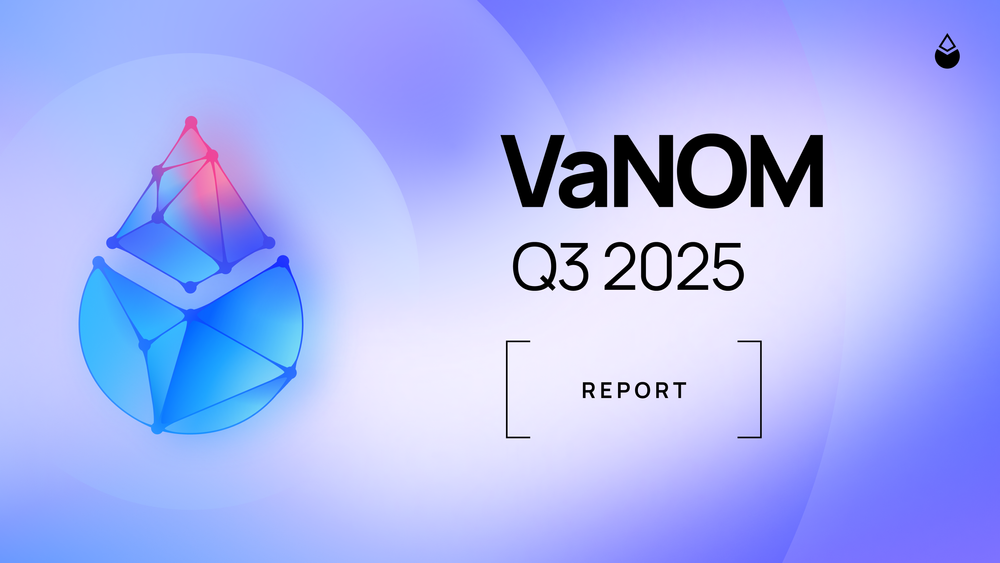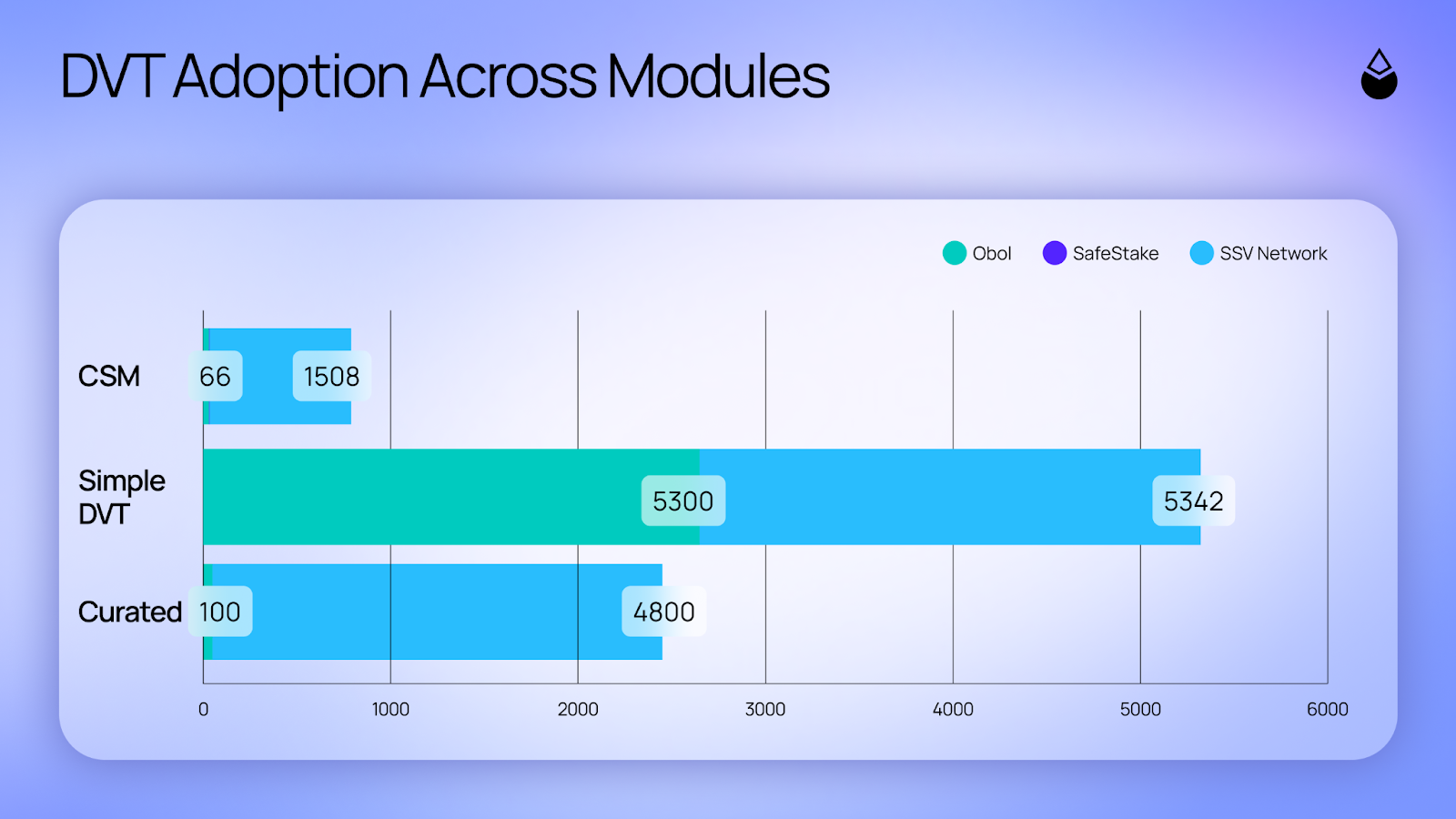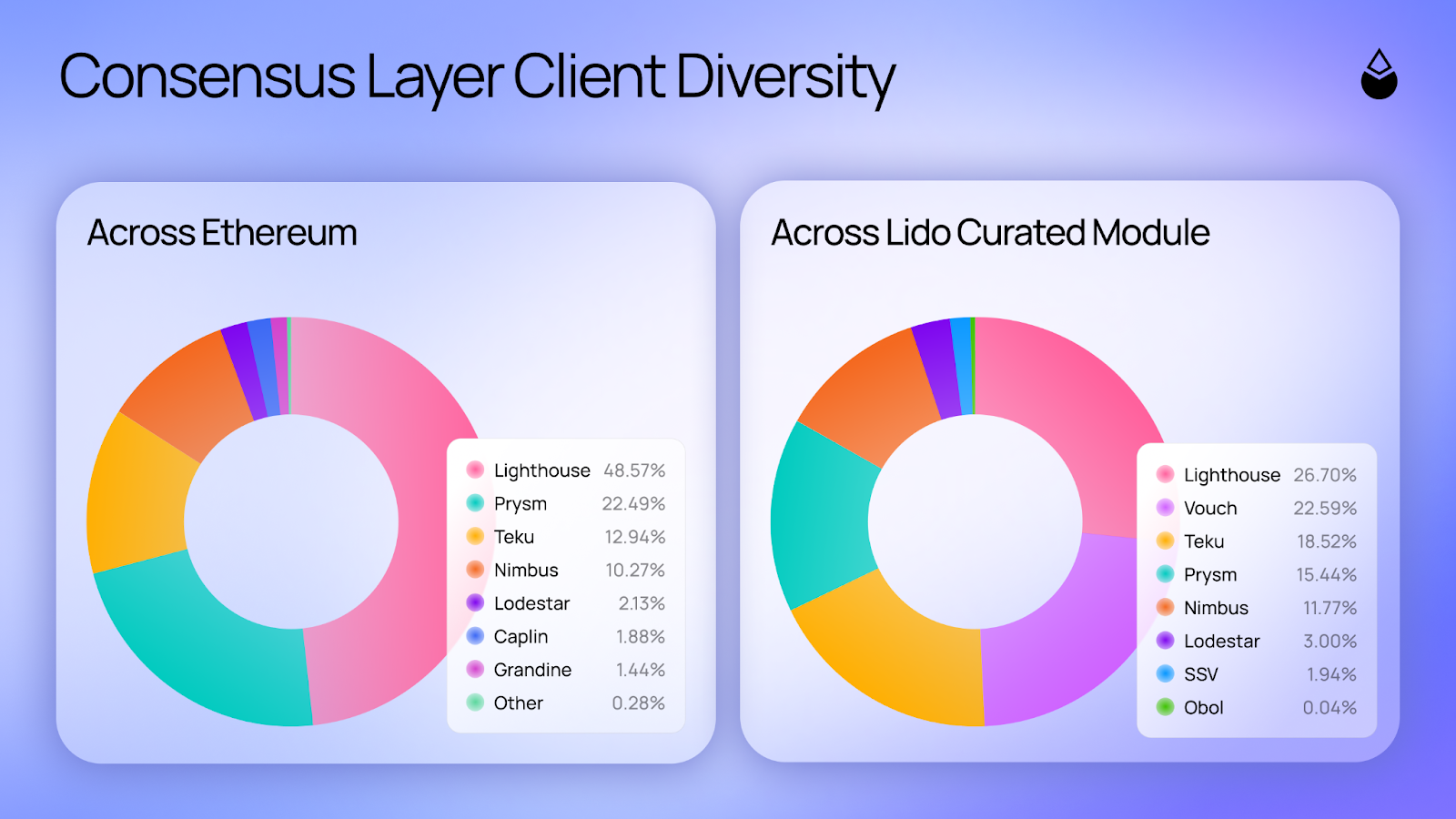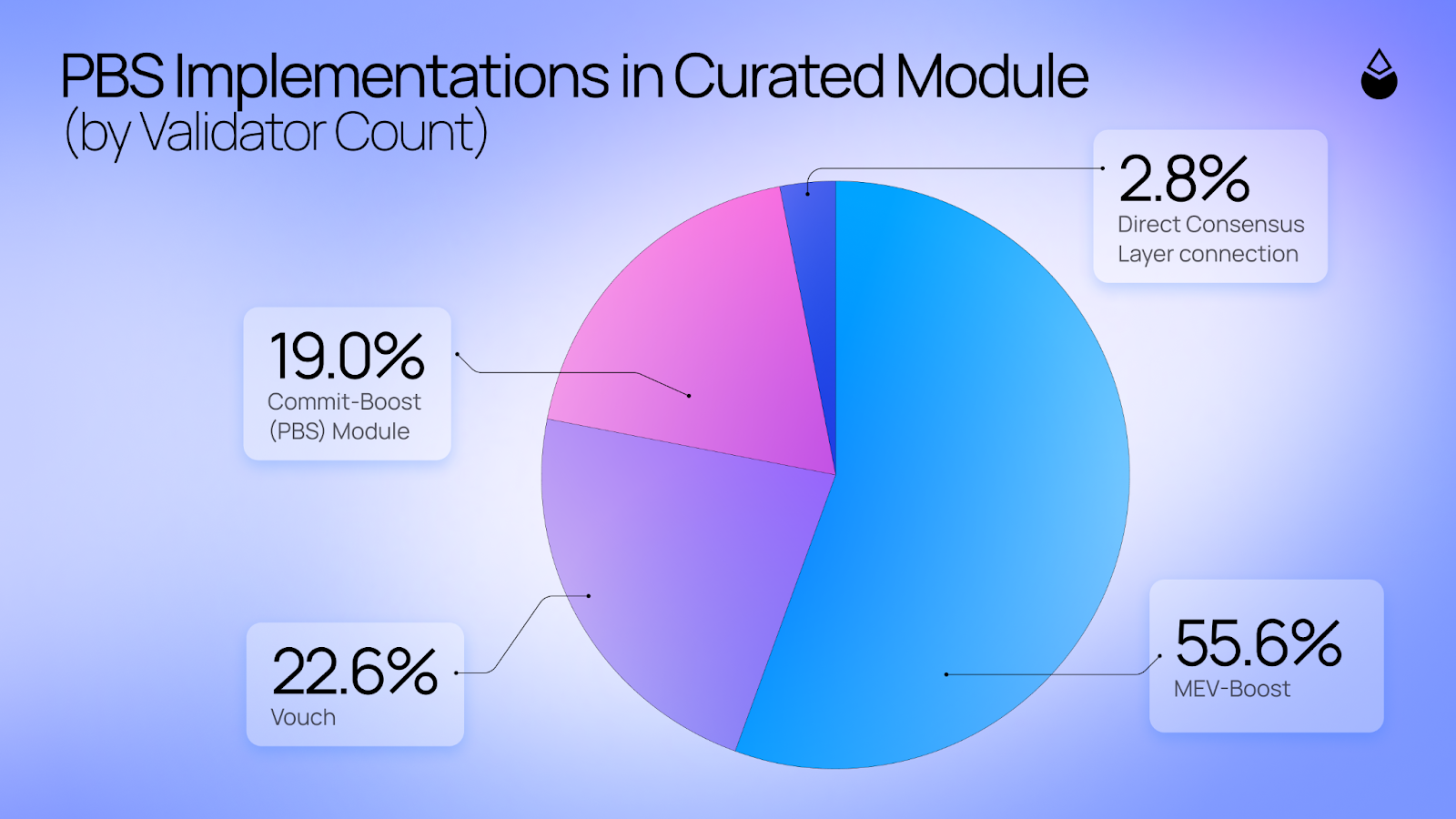Lido Validator and Node Operator Metrics: Q3 2025

Highlights
- +9.46% growth in unique Node Operators with 59 new operators joining (most through the Community Staking Module).
- ~545,000 staked ETH now operated using Distributed Validator Technology (DVT) via Obol, SafeStake and SSV Network.
- Introduction of a new section on Auxiliary Proposer Mechanisms (APMs), detailing how Lido Node Operators utilize various block proposal mechanisms on Ethereum.
The latest Q3 2025 VaNOM report is now live and available here.
Basic Stake & Operators Statistics
In Q3 2025, both the Simple DVT Module and the Community Staking Modules reached their respective stake share limits—4% and 3%—together accounting for roughly 600,000 staked ETH within the Lido protocol. As of October 1, 2025, these two decentralized modules represented 1.67% of the total Ethereum stake, marking continued progress toward diversifying and empowering permissionless participation in the Lido Node Operator set.
- Community Staking Module (CSM)The CSM recorded the strongest growth across the Lido Staking Modules (SM), expanding by 0.99 percentage points (+72,448 ETH) and reaching its 3% stake share limit. On October 2, this cap was increased to 5% as part of the CSM v2 upgrade.
- Simple DVT Module (SDVTM) The SDVTM added 32,224 ETH (+0.61pp), with all clusters—36 regular Obol, 36 regular SSV Network, and 10 Super Clusters (five on Obol and five using SSV Network)—fully allocated by the quarter’s end. The module also reached its 4% limit share set by the Lido DAO.
- Curated Module The largest Lido SM saw a 1.59pp decrease, or 680,032 ETH reduction in stake, as most protocol withdrawals were processed through it. Around one-third (223,456 ETH) of those withdrawals were a precautionary measure in response to the Kiln security incident, which prompted the exit of 6,983 validators operated by the Kiln team. Pier Two, previously running 1,000 active validators, was allocated 2,766 additional ones, reaching a total of 3,766 by the third quarter’s end, thereby improving the stake distribution balance across the Curated Module.

Distributed Validator Technology Adoption
Up until the previous quarter, the Simple DVT and the Community Staking were the only modules within the Lido protocol utilizing Distributed Validator Technology (DVT) through Obol, SafeStake, and the SSV Network solutions.
As DVT adoption across Ethereum has accelerated and it has proven the reliability in both the SDVTM and CSM, Lido contributors proposed extending DVT usage to the Curated Module, allowing operators in the Curated Set to opt into intra-operator DVT setups. This proposal was approved by LDO tokenholders during the June 2025 voting slot, marking a key step toward further protocol decentralization and enhanced fault tolerance.
As of October 1, 2025, a total of 547,968 ETH (17,124 validators) across the protocol are powered by Obol, SafeStake, and SSV Network DVT implementations.
Following rigorous testing on the Hoodi testnet, Q3 2025 saw the first five Curated Node Operators — A41, Blockscape, Ebunker, RockX, and Stakin — successfully migrated 4,900 validators (156,800 ETH) to Obol and SSV Network setups. This shift increased total DVT utilization across the Lido protocol to 17,124 validators, a 57.65% quarter-over-quarter rise from 10,862 validators in Q2 2025.

In the Simple DVT Module, 5,300 validators use Obol and 5,342 use SSV Network setups-up by +80 and +1,087 from Q2, respectively-run by 217 and 229 operators.
Within the CSM, where DVT usage is fully voluntary, its adoption also expanded: 332 more validators utilize the SSV Network, compared to the second quarter, and 66 validators across eight operators are supported by Obol. SafeStake, utilized in the CSM only, maintains a steady eight validators operated by four operators.
This adoption across different staking modules clearly demonstrates how DVT is becoming increasingly common among the Lido validator setup. Collectively, this growing DVT utilization—from permissionless to the Curated Module—reflects Lido’s continued progress toward a more decentralized, diversified, and robust validator network.
Curated Module Consensus Client Diversity
The adoption of Obol and SSV Network DVT setups within the Curated Module further expanded Consensus Layer (CL) client diversity, thereby contributing to a reduction of the probability of supermajority and finality risks. Starting Q3 2025, these setups have powered 5,900 Curated Module validators, resulting in 1.94% now operating via SSV Network (4,800 validators) and 100 using Obol, which has recently begun ramping up and is expected to increase in the coming quarters.
Beyond DVT-related client setups, Vouch, developed by Attestant, remains a key component in this diversification. Designed to work with multiple Beacon Nodes, it provides additional flexibility and security and is now used by 22.59% of CM validators.
When compared to the pan-Ethereum CL client landscape, where Lighthouse remains dominant at 48.57% (up from 47.96% in Q2), Lido’s Curated Module maintains a more balanced distribution.
- Lighthouse and Vouch each account for roughly a quarter of all Curated Module validators (26.70% and 22.59%, respectively, with minor quarterly variation).
- They are followed closely by Teku (18.52%) and Prysm (15.44%).
- Nimbus grew modestly to 11.77%, keeping up its share with other clients in the Curated Module set.

This consistent diversification across Lido’s Curated Module is a result of the Node Operators' commitment to client diversity and fault-tolerance to mitigate supermajority and correlated failure risks. By fostering balanced usage across multiple CL clients, Lido continues to strengthen Ethereum’s overall health and network resilience.
Auxiliary Proposer Mechanisms Utilization
The Auxiliary Proposer Mechanisms (APM) framework enables Lido to safely explore and adopt emerging tools related to block proposal on Ethereum, while maintaining the protocol's decentralization and security standards. These mechanisms, designed to enhance block production efficiency, reliability, and flexibility, are integral to Ethereum’s evolving architecture and can’t be ignored as they unlock potential rewards for stakers and new efficiencies for Node Operators.
The chart below illustrates how Node Operators in the Curated Module are adopting available infrastructure setups as of Q3 2025. A well-known example is Proposer-Builder Separation (PBS), a design that separates block building from block proposing to prevent transaction censorship at the network level and improve fairness in block rewards. Its most widely adopted implementation, MEV-Boost, is currently used by around half of the Lido validators.
Other APM implementations active within the Lido protocol include: Vouch utilized by 22.6% of operators; Commit Boost’s PBS Module-by 19% of operators.
Additionally, Consensus Layer clients' native support of direct interaction with the MEV Boost Protocol are used only by 2.8% of Lido validators, as it offers more limited functionality compared to the MEV-Boost sidecar setup.

The pie chart above reflects Lido contributors’ conscientious approach to adopting APMs, ensuring that as Ethereum’s proposer infrastructure evolves the Lido protocol remains at the forefront of innovation without compromising on safety or ethics.
Looking Ahead
The months leading up to 2026 are set to bring more improvements across the Lido Validator Set. On October 2, the CSM v2 upgrade went live on mainnet, increasing stake share limit to 5%, introducing differentiated parameters for various Node Operator (NO) types, and enabling the optional Identified Community Staker (ICS) framework. The latter marks a significant milestone in Lido’s roadmap, empowering more independent operators to participate in Ethereum validation. Expect upcoming quarters to reflect these changes across CSM-related metrics and validator charts.
Continuation of DVT adoption within the Curated Module is also on the horizon, following commitments made by the CM Node Operators on the Lido Research Forum, which will further strengthen validator resilience and diversity within the set.
Finally, the forthcoming Lido V3, Staking Router v3, and Curated Module v2 upgrades will collectively reshape how Node Operators engage with the protocol, expanding flexibility, improving modularity, and setting the stage for the next phase of Ethereum staking evolution.
As always, Lido DAO contributors will continue to refine the protocol’s metrics and dashboards to reflect its growing complexity and ensure data-driven accountability. Stay tuned for the next VaNOM update—and in the meantime, explore the Lido Node Operator Portal and Validator Set Updates for monthly insights.